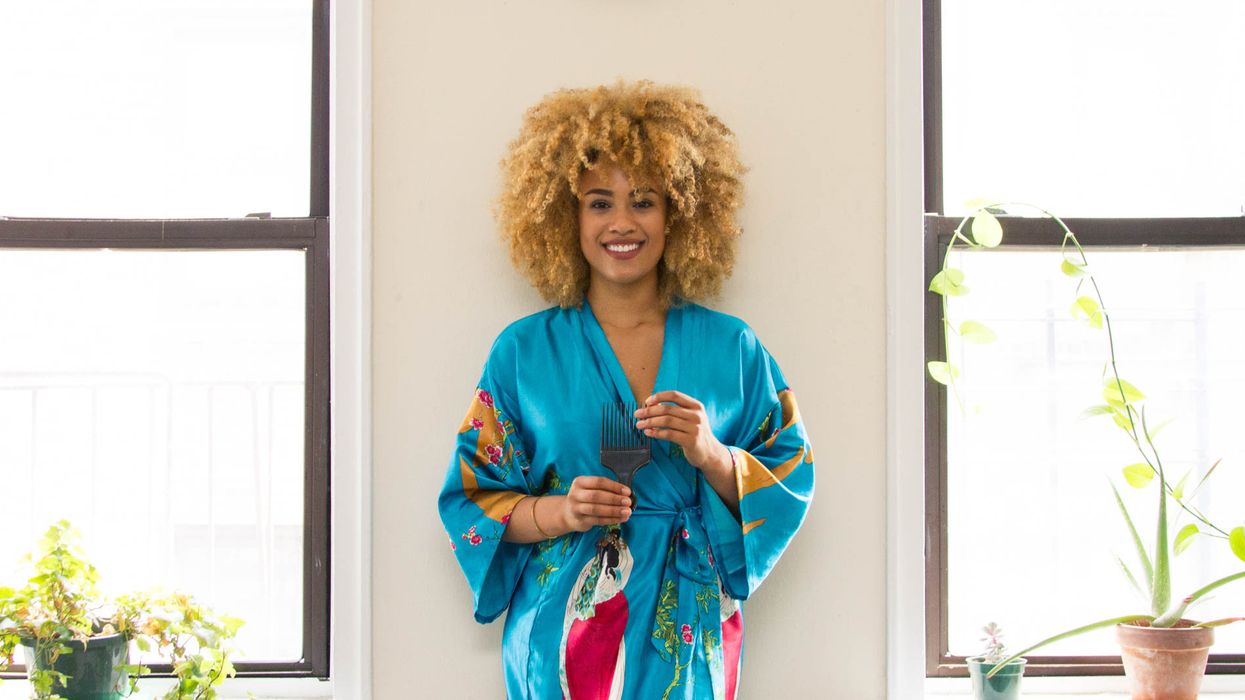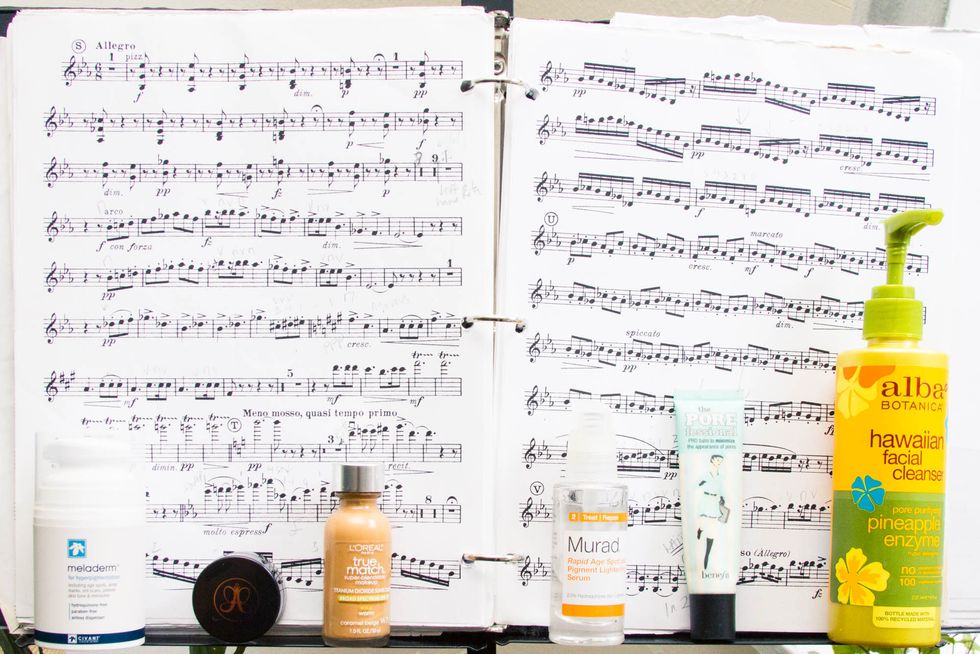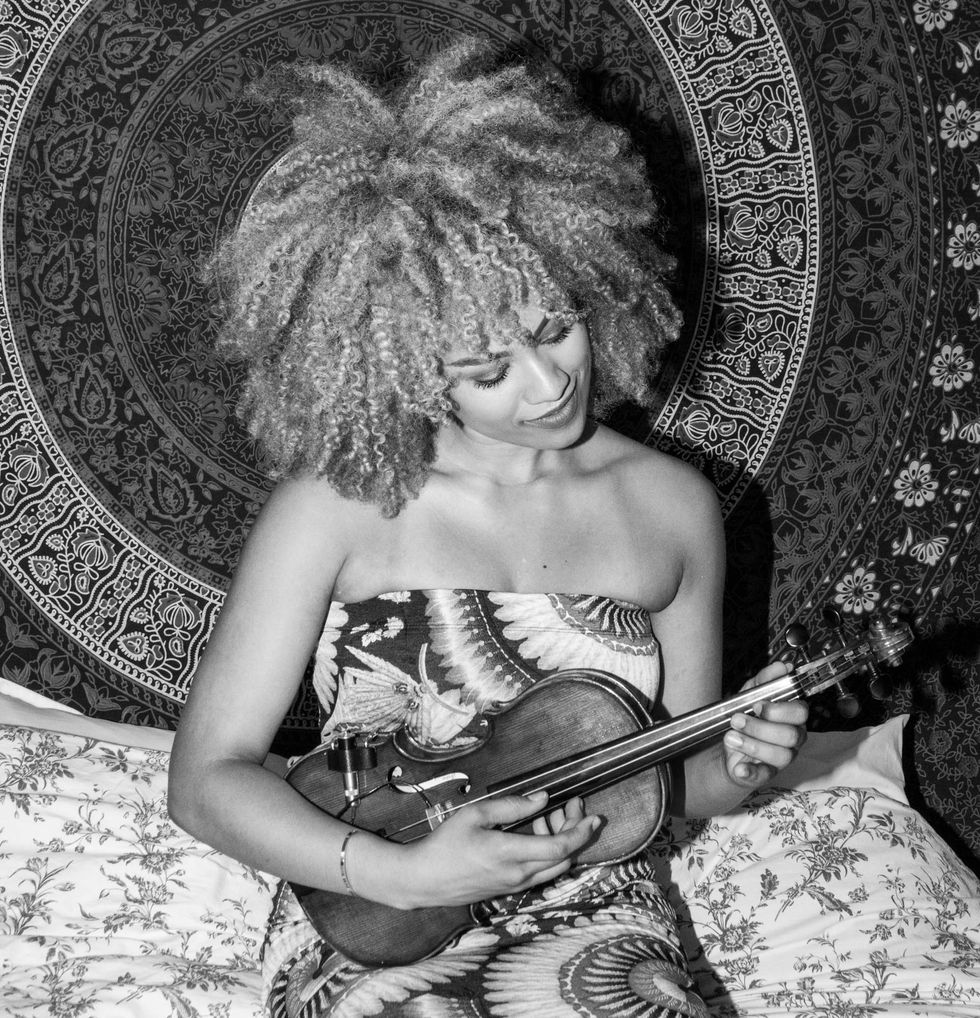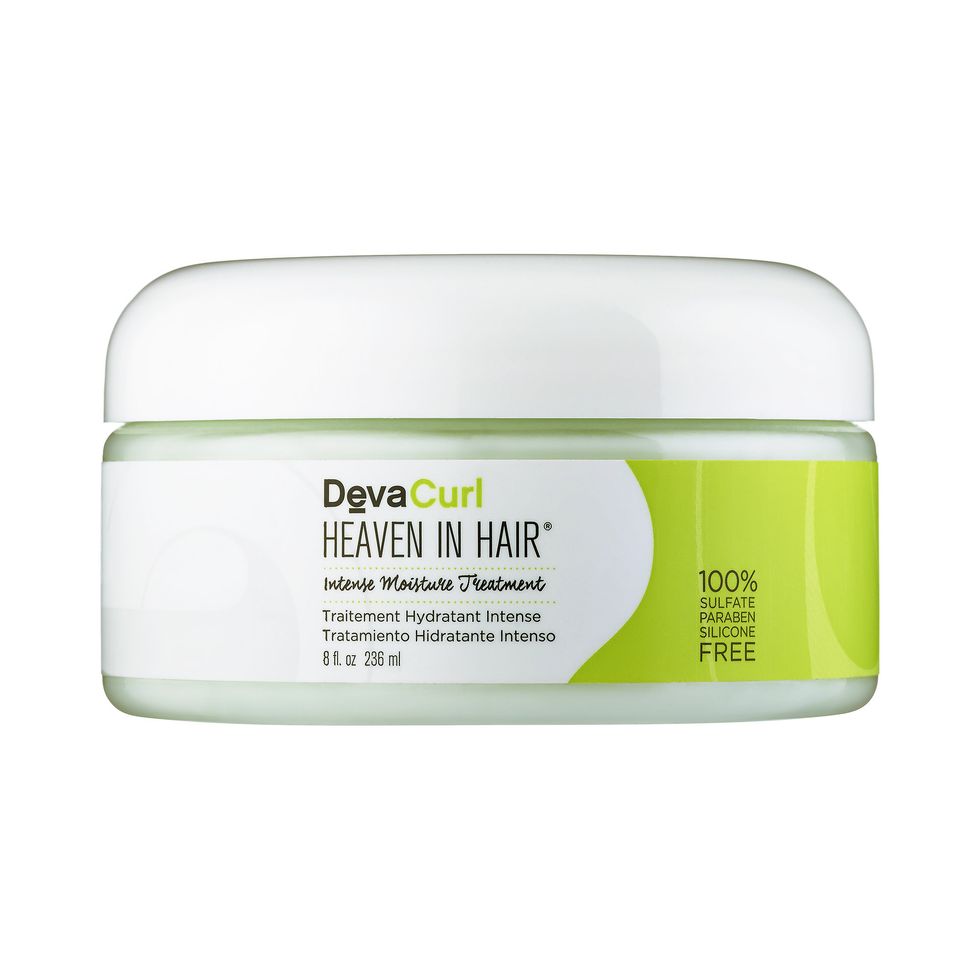This Violinist's Drake & Rihanna Covers (& Her Hair) Are Changing The Game
Musician Ezinma talks visibility, the best conditioner for curls and bleaching black hair.

We're suckers for anyone who goes by a mononym. There’s something about going by a single name that screams, 'I'm about to blow the eff up.' Take Ezinma, for example. The mind-blowingly talented violinist, whose covers of basically everything we're listening to this summer (Drake, Rihanna, Desiigner, Lemonade) started creeping up on our Instagram feeds a few weeks ago (see them for yourself and watch the Facebook Live performance we did with her here) and we've been obsessed ever since. What we've been most moved by, though, are Ezinma's own social posts between the music—the ones that serve to create dialogue around what it means to be black and creating work in the classical music space. So we swung by her Inwood apartment to discuss using 'Panda' to bring people together (yup), her personal hair history, that time she cut it all off, and exactly how she gets *those* curls.
Her hair history:
“My dad is Guyanese. He’s black and my mom is white; she’s German but American-born. My dad’s bald, and my mom doesn’t know anything about curly hair. So, growing up my hair was a disaster! I had the puffs—my mom didn’t know what to do and my dad didn’t know what to do. If my aunties were in town they would cornrow it, but it was always wild. When I hit eighth grade, I started getting relaxers and chemically straightening my hair. It was a lot of work, and when I was about 19, I cut it all off. I was reading a lot of, Audre Lorde, Malcolm X-type stuff and I realized, 'why am I straightening my hair, what is this for?' I just cut it all off and went natural.
“Since then, it’s always been curly. I don’t even straighten it for fun. It’s mainly out of laziness, because I don’t have anything wrong with straightening your hair or anything like that. It's just my personality; it's who I am.”

She didn’t always love her hair:
“My mom has long, beautiful, blonde, thick, luscious hair, and I remember being little and always telling her, ‘I wish my hair would swish down my back like yours’ or, ‘I wish I could put it behind my ears and it wouldn’t stick up.’ There was a lot of wishing for that whiteness in my hair. But I also grew up in Nebraska, and there weren’t very many biracial or black people. My dad is not from America, so I also didn’t fit into American black culture or white culture. It was a really confusing thing. I also was a classical violinist and there were a lot of different forces in my life that did play out in my hair and really hating my hair. Hating how it was nappy, kinky and curly, and not really knowing what to do with it.”
How cutting off all her hair (& moving to New York) helped her set the reset button:
“When I cut it all off and I had my itty bitty fro, it was hard re-establishing and reconnecting with my hair and my identity; taking ownership of it. Saying, 'I am black, this is who I am, this is my hair, I’m going to embrace it and love it and celebrate it'... it definitely hasn’t been easy. But now where I am, living in New York, there’s so many beautiful hair textures and people of all races together. It’s much easier in a place like here than in Nebraska. Now I completely love it. I’m probably going to be curly for the rest of my life.”

Why visibility & representation are everything:
“I think my job is by simply playing the violin the way that I do, having the skin that I do, wearing my hair proudly in a giant afro when I play... that is what entices little black girls to say, ‘I want to meet her, she looks like me, she does something that black women don’t usually do.’ And that is my job. By performing and just being proud of my blackness, and especially because my blackness doesn’t fit the stereotype that this country has boxed black people to be. You know, Misty Copeland broke so many boundaries. I love Misty, when I was a little girl she was my everything. That is activism. Putting a black man in the White House is activism; nobody ever thought that was going to happen. And by simply being a classical violinist with big nose, big lips, hair—that’s activism.”
What it's like to be both a woman of color and classical violinist (& what hair has to do with it):
“It’s one of those things where it’s a very white, affluent culture and tradition. There were a lot of times when I would see people who weren’t as good as me advance and do better. A lot of that was because I didn’t look like a classical violinist. I never really felt like I fit in, and I think that’s a part of the reason why I also turned to what I’m doing now, which is interesting.
“I was the only non-white or non-Asian violinist in my state. In the whole state! Lots of teachers didn’t want to see [that]—you know, I was told things like, 'why are you doing violin?' But my parents have been very supportive and very firm in always supporting me.”

The secrets to her success (& how she's making classic music relevant again):
“I think first of all, dedication. Every time you get rejected, something else is going to happen. Make opportunities for yourself. Classical music is done; it’s a fact. People don’t go to operas anymore. The Met isn’t selling out the way it used to. People don’t want to buy Beethoven’s music and that makes perfect sense because that music isn’t relevant to us anymore. I think for classically trained artists, you must keep in mind people of today when you’re creating. It’s about sharing it with other people. And I found that with playing 'Panda,' I have people jumping, totally into it, loving the violin. The coolest part is I like to slip in Mozart or things from Carmen, and people don’t even know. That’s just so fun to me. I think any time you take tradition and turn it around, that’s when you break boundaries and that’s when you’re heard and that’s when people respond. Walking safely and following tradition is great, but I don’t want to be that kind of artist. I did that for a long time and I learned a lot, but now I’m like, ‘let’s get people going, let’s bring people of different cultures together and different musical backgrounds together.’”

The decision to go blonde:
“I don’t have any interest in straightening my hair and I wanted a change, and when your hair is curly and big, there’s really not much you can do. You can make it smaller, you can get it cut, but I wanted to keep the length so I decided to color it. I have a guy, Brian, who I trust dearly with my hair and he’s like, ‘why not blonde?’ I just did it. After I did, I was crying. I loved it but it’s just a huge change. It was really scary, and it’s just hard to see yourself in a different way. I’ll probably go back to dark, but I don’t know when.”
What her hair care routine looks like now:
“I don’t use sulfates or parabens or anything like that. I try to use really good products in my hair. I cleanse once a week with a NoPoo by Deva, but I try not to do it too much because I don’t want it to get dry, especially because it’s color-treated. Sometimes I use Carol’s Daughter to condition, they have a vanilla pudding cream and I use that to detangle, or I use DevaCurl Decadence Conditioner. I comb it through with my fingers, I leave it in, I do my other stuff in the shower, and then I rinse it. And I use Heaven and Hair by Deva. I leave it in, and if I want lots of definition, Diva has a gel, but if I feel like I just wanna go fluffy and big I just leave [Heaven in Hair] in.”
The beauty advice she'd give to her 15-year-old self:
“Just love yourself, girl. And pluck your brows a little bit more! But really love yourself!”


